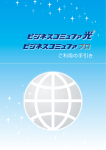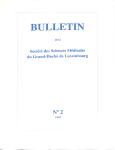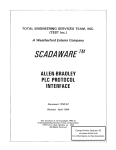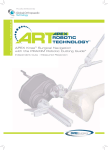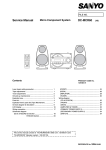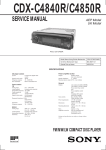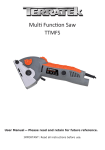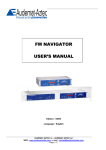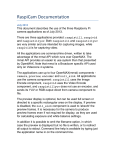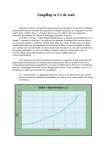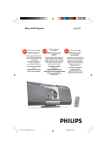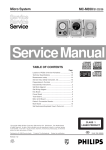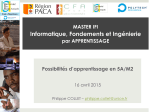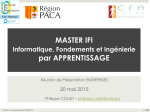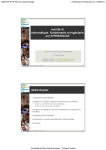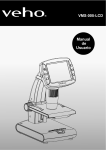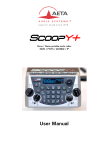Download Page 1-1 to 3 A4 pages
Transcript
Micro System MCM275 all versions Service Service Service Service Manual COMPACT TABLE OF CONTENTS DIGITAL AUDIO Page Location of pc boards & Version variations ................ 1-2 Technical Specifications ............................................. 1-3 Measurement setup .................................................... 1-4 Service Aids, Safety Instruction, etc. ............... 1-5 to 1-6 Lead-free Information & Service Instruction .............. 1-7 Preparations & Controls & Troubleshooting .. 1-8 to 1-10 Troubleshooting ........................................................ 1-11 Disassembly Instructions & Service positions .............. 2 Service Test Programs ............................................... 3-1 Set Block diagram ...................................................... 4-1 Set Wiring diagram ..................................................... 5-1 Main Board .................................................................... 6 CD/MCU Board .............................................................. 7 AC Power Board ............................................................ 8 Set Mechanical Exploded view & parts list ................... 9 Revision List ................................................................ 10 © Copyright 2006 Philips Consumer Electronics B.V. Eindhoven, The Netherlands CLASS 1 LASER PRODUCT All rights reserved. No part of this publication may be reproduced, stored in a retrieval system or transmitted, in any form or by any means, electronic, mechanical, photocopying, or otherwise without the prior permission of Philips. Published by SL 0619 Service Audio Version 1.1 Printed in The Netherlands Subject to modification GB 3141 785 30332 1-2 VERSION VARIATIONS VERSION VARIATIONS: Type /Versions: MCM275 Features & Board in used: /05 /12 Aux in / CDR in Line Out x x Matrix Surround RDS x x News x x x x x x x x /37 x /98 x Video Out Surround Out Subwoofer Out Power Booster Out Digital Out Digital in Dolby Pro Logic (DPL) Incredible Surround Karaoke Features Voltage Selector ECO Power Standby (LCD Display Off) x ECO6 Tuner Board - Systems Non-Cenelec ECO6 Tuner Board - Systems Cenelec USB Direct x x x x x 1-3 SPECIFICATIONS GENERAL: Mains voltage : 127/240V -15%+10% Switchable for /98 120V ± 10% for /37 Dynamic Bass Boost (DBB) Input sensitivity Aux in (at 1kHz) : 500mV at 600 Ω USB : Host 230V ± 10% for /05/12 Mains frequency Clock accuracy : 50/60Hz : < 4 seconds per day Dimension centre unit : xx x xx x xx (mm) : ON / OFF Output sensitivity Headphone output at 32 Ω : 10mW ± 2dB (Max. vol.) COMPACT DISC: Power consumption Active : 20W Standby : < 5.5W (DEMO mode) Frequency response within ± 3dB : 125Hz - 16kHz Output level (in Vrms) : 500mV, Zout = 100Ω ECO Power Standby : < 0.5W for /05/12/37 Signal/Noise ratio (unw.) : > 65dB Signal/Noise ratio (A-weighted) : > 76dB Distortion at 1kHz : < 0.02% TUNER: Channel unbalance (-40dB) Channel separation at 1kHz : < ±2dB : > 30dB FM Emphasis : 15/50 µS (switched Tuning range : 87.5-108MHz Grid : 50kHz for /98/12/05 100kHz for /98/55/37 IF frequency : 10.7MHz ± 20kHz Aerial input : 75 Ω coaxial /05/12/98 Sensitivity at 26dB S/N 300 Ω for /37 : < 22µf automatically by CD10) THD Noise(1kHz,500mW) : < 1.0% Volume attenuation(1kHz) : > 60dB MP3 CD WMA: MP3 : MPEG 1 (ISO/IEC 11172-3) Layer3 MP3-CD Bit Rate WMA-CD Bit Rate Sampling Rate Distortion at RF=1mV, dev. 75kHz : < 3% Format : 8-320 kbps : 64-192 kbps : 8, 11.025, 12, 16, 22.05, 24, 32, 44.1, 48 kHz : ISO9660, Joliet,UDF -3dB Limiting point Crosstalk at RF=1mV, dev. 40kHz : < 23.5dBf : > 18dB ID3 : V1 tag/V2 2.0/V2 3.0 Language Support : English Selectivity at 300kHz bandwidth : > 25dB Image rejection IF rejection : > 25dB [> 75dB] : > 60B [> 80dB] MW Tuning range : 531-1602kHz for /05/12/55/98 Grid : 9kHz for /05/12/55/98 530-1700kHz for /37/98 10kHz for /37/98 : 450kHz ± 1kHz : Frame aerial 18.1µH IF frequency Aerial input Sensitivity at 26dB S/N : < 4.4mV/M Selectivity at 300kHz bandwidth IF rejection : > 18dB : > 45dB Image rejection : > 28dB Distortion at RF=50mV, M=80% : < 5% AMPLIFIER: Output power L&R : 2 x 5.0W (4Ω, 1kHz, 10% THD) : 2 x 4.5W (4Ω, 1kHz, 10% THD) /98 : 2 x 4.5W (FTC Power, 4Ω, 1kHz, 10% THD 63Hz-12.5kHz) /37 Frequency response within -3dB : 50Hz-16kHz Digital Sound Control (DSC) : Jazz / Rock / Pop / Classic [....] Values indicated are for /05/12 only. 1-4 MEASUREMENT SETUP Tuner FM Bandpass 250Hz-15kHz DUT e.g. 7122 707 48001 RF Generator LF Voltmeter e.g. PM2534 Ri=50Ω e.g. PM5326 S/N and distortion meter e.g. Sound Technology ST1700B Use a bandpass filter to eliminate hum (50Hz, 100Hz) and disturbance from the pilottone (19kHz, 38kHz). Tuner AM (MW,LW) Bandpass 250Hz-15kHz DUT e.g. 7122 707 48001 LF Voltmeter e.g. PM2534 RF Generator e.g. PM5326 S/N and distortion meter Ri=50Ω e.g. Sound Technology ST1700B Frame aerial e.g. 7122 707 89001 To avoid atmospheric interference all AM-measurements have to be carried out in a Faraday´s cage. Use a bandpass filter (or at least a high pass filter with 250Hz) to eliminate hum (50Hz, 100Hz). Recorder CD Use Audio Signal Disc (replaces test disc 3) SBC429 4822 397 30184 Use Universal Test Cassette CrO2 SBC419 4822 397 30069 or Universal Test Cassette Fe SBC420 4822 397 30071 LF Generator DUT e.g. PM5110 L DUT L R R S/N and distortion meter S/N and distortion mete e.g. Sound Technology ST1700B e.g. Sound Technology ST1700B LEVEL METER e.g. Sennheiser UPM550 with FF-filter LEVEL METER e.g. Sennheiser UPM550 with FF-filter 1-5 SERVICE AIDS Service Tools: ESD Equipment: Universal Torx driver holder .................................4822 395 91019 Anti-static table mat - large 1200x650x1.25mm ...4822 466 10953 Torx bit T10 150mm ...........................................4822 395 50456 anti-static table mat - small 600x650x1.25mm .....4822 466 10958 Torx driver set T6-T20 .........................................4822 395 50145 Anti-static wristband ............................................4822 395 10223 Torx driver T10 extended .....................................4822 395 50423 Connectorbox (1MΩ) ..........................................4822 395 11307 Extension cable (to connect wristband to conn.box) ..........4822 320 11305 Connecting cable Compact Disc: (to connect table mat to conn.box) ...........4822 320 11306 SBC426/426A Test disc 5 + 5A ...........................4822 397 30096 Earth cable (to Connect product to mat or box) --4822 320 11308 SBC442 Audio Burn-in test disc 1kHz .................4822 397 30155 Complete kit ESD3 SBC429 Audio Signals disc .................................4822 397 30184 (combining all above products) ...............4822 320 10671 Dolby Pro-logic Test Disc ....................................4822 395 10216 Wristband tester ...................................................4822 344 13999 HANDLING CHIP COMPONENTS 1-6 GB NL ESD WARNING Alle IC’s en vele andere halfgeleiders zijn gevoelig voor electrostatische ontladingen (ESD). Onzorgvuldig behandelen tijdens reparatie kan de levensduur drastisch doen verminderen. Zorg ervoor dat u tijdens reparatie via een polsband met weerstand verbonden bent met hetzelfde potentiaal als de massa van het apparaat. Houd componenten en hulpmiddelen ook op ditzelfde potentiaal. All ICs and many other semi-conductors are susceptible to electrostatic discharges (ESD). Careless handling during repair can reduce life drastically. When repairing, make sure that you are connected with the same potential as the mass of the set via a wrist wrap with resistance. Keep components and tools also at this potential. F WAARSCHUWING ATTENTION I Tous les IC et beaucoup d’autres semi-conducteurs sont sensibles aux décharges statiques (ESD). Leur longévité pourrait être considérablement écourtée par le fait qu’aucune précaution n’est prise à leur manipulation. Lors de réparations, s’assurer de bien être relié au même potentiel que la masse de l’appareil et enfiler le bracelet serti d’une résistance de sécurité. Veiller à ce que les composants ainsi que les outils que l’on utilise soient également à ce potentiel. D AVVERTIMENTO WARNUNG Alle ICs und viele andere Halbleiter sind empfindlich gegenüber elektrostatischen Entladungen (ESD). Unsorgfältige Behandlung im Reparaturfall kan die Lebensdauer drastisch reduzieren. Veranlassen Sie, dass Sie im Reparaturfall über ein Pulsarmband mit Widerstand verbunden sind mit dem gleichen Potential wie die Masse des Gerätes. Bauteile und Hilfsmittel auch auf dieses gleiche Potential halten. Tutti IC e parecchi semi-conduttori sono sensibili alle scariche statiche (ESD). La loro longevità potrebbe essere fortemente ridatta in caso di non osservazione della più grande cauzione alla loro manipolazione. Durante le riparazioni occorre quindi essere collegato allo stesso potenziale che quello della massa dell’apparecchio tramite un braccialetto a resistenza. Assicurarsi che i componenti e anche gli utensili con quali si lavora siano anche a questo potenziale. GB Safety regulations require that the set be restored to its original condition and that parts which are identical with those specified, be used. “Pour votre sécurité, ces documents doivent être utilisés par des spécialistes agréés, seuls habilités à réparer votre appareil en panne”. NL Veiligheidsbepalingen vereisen, dat het apparaat bij reparatie in zijn oorspronkelijke toestand wordt teruggebracht en dat onderdelen, identiek aan de gespecificeerde, worden toegepast. CLASS 1 LASER PRODUCT 3122 110 03420 F Les normes de sécurité exigent que l’appareil soit remis à l’état d’origine et que soient utiliséés les piéces de rechange identiques à celles spécifiées. GB Warning ! Invisible laser radiation when open. Avoid direct exposure to beam. D Bei jeder Reparatur sind die geltenden Sicherheitsvorschriften zu beachten. Der Original zustand des Geräts darf nicht verändert werden; für Reparaturen sind Original-Ersatzteile zu verwenden. S Varning ! Osynlig laserstrålning när apparaten är öppnad och spärren är urkopplad. Betrakta ej strålen. SF Varoitus ! I Le norme di sicurezza esigono che l’apparecchio venga rimesso nelle condizioni originali e che siano utilizzati i pezzi di ricambio identici a quelli specificati. Avatussa laitteessa ja suojalukituksen ohitettaessa olet alttiina näkymättömälle laserisäteilylle. Älä katso säteeseen! DK Advarse ! "After servicing and before returning set to customer perform a leakage current measurement test from all exposed metal parts to earth ground to assure no shock hazard exist. The leakage current must not exceed 0.5mA." Usynlig laserstråling ved åbning når sikkerhedsafbrydere er ude af funktion. Undgå udsaettelse for stråling. 1-7 INFORMATION ABOUT LEAD-FREE SOLDERING Philips CE is producing lead-free sets from 1.1.2005 onwards. IDENTIFICATION: Regardless of special logo (not always indicated) one must treat all sets from 1 Jan 2005 onwards, according next rules: Example S/N: Bottom line of typeplate gives a 14-digit S/N. Digit 5&6 is the year, digit 7&8 is the week number, so in this case 2005 wk12 So from 0501 onwards = from 1 Jan 2005 onwards Important note: In fact also products of year 2004 must be treated in this way as long as you avoid mixing solder-alloys (leaded/ lead-free). So best to always use SAC305 and the higher temperatures belong to this. Due to lead-free technology some rules have to be respected by the workshop during a repair: • Use only lead-free solder alloy Philips SAC305 with order code 0622 149 00106. If lead-free solder-paste is required, please contact the manufacturer of your solder-equipment. In general use of solder-paste within workshops should be avoided because paste is not easy to store and to handle. • Use only adequate solder tools applicable for lead-free solder alloy. The solder tool must be able o To reach at least a solder-temperature of 40 o To stabilize the adjusted temperature at the solder-tip o To exchange solder-tips for different applications. − is reached and stabilized at the solder joint. Heating-time of the Adjust your solder tool so that a temperature around solder-joint should not exceed ~ 4 sec. Avoid temperatures above 400 otherwise wear-out of tips will rise drastically and flux-fluid will be destroyed. To avoid wear-out of tips switch off un-used equipment, or reduce heat. Mix of lead-free solder alloy / parts with leaded solder alloy / parts is possible but PHILIPS recommends strongly to avoid mixed solder alloy types (leaded and lead-free). If one cannot avoid or does not know whether product is lead-free, clean carefully the solder-joint from old solder alloy and re-solder with new solder alloy (SAC305). Use only original spare-parts listed in the Service-Manuals. Not listed standard-material (commodities) has to be purchased at external companies. Special information for BGA-ICs: - always use the 12nc-recognizable soldering temperature profile of the specific BGA (for de-soldering always use the lead-free temperature profile, in case of doubt) - lead free BGA-ICs will be delivered in so-called 'dry-packaging' (sealed pack including a silica gel pack) to protect the IC against moisture. After opening, dependent of MSL-level seen on indicator-label in the bag, the BGA-IC possibly still has to be baked dry. (MSL=Moisture Sensitivity Level). This will be communicated via AYS-website. Do not re-use BGAs at all. • • • • • For sets produced before 1.1.2005 (except products of 2004), containing leaded solder-alloy and components, all needed spare-parts will be available till the end of the service-period. For repair of such sets nothing changes. • On our website www.atyourservice.ce.Philips.com you find more information to: ∗ ∗ BGA-de-/soldering (+ baking instructions) Heating-profiles of BGAs and other ICs used in Philips-sets You will find this and more technical information within the "magazine", chapter "workshop news". For additional questions please contact your local repair-helpdesk. SERVICE INSTRUCTION Safety regulations require that after a repair, the set must be returned in its original condition. Pay in particular attention to the following points: · · · · Route the wire trees correctly and fix them with the mounted cable clamps. Check the insulation of the AC Power lead for external damage. Check the strain relief of the AC Power cord for proper function. Check the electrical DC resistance between the AC Power Plug and the secondary side (only for sets which have a AC Power isolated power supply): 1. Unplug the AC Power cord and connect a wire between the two pins of the AC Power plug. 2. Set the AC Power switch to the "on" position (keep the AC Power cord unplugged!). 3. Measure the resistance value between the pins of the AC Power plug and the metal shielding of the tuner or the aerial connection on the set. The reading should be larger than 4.5 Mohm (For U.S. it should be between 4.2 Mohm and 12 Mohm). 4. Switch "off" the set, and remove the wire between the two pins of the AC Power plug. • Check the cabinet for defects, to avoid touching of any inner parts by the customer. 4 1 2 3 TH IUM CR 2 02 3 2 5 LI CAUTION! – Remove the battery if it is exhausted or will not be used for a long time. – Batteries contain chemical substances, so they should be disposed of properly. 1 Put back the battery tray. Remove the old battery and put a new CR2025 battery in place. Press and hold 1 as indicated. Simultaneously, pull the battery tray at 4. To replace the remote controls’ battery Notes for remote control: – First select the source you wish to control by pressing one of the source select keys on the remote control (for example CD,TUNER). – Then select the desired function (for example ÉÅ, í, ë). – Always point the remote control directly towards IR area. – Remove the protective plastic tab before using the remote control. IMPORTANT! Using the remote control Preparation 6 5 4 3 2 1 USB / Helpful hints: – The clock setting will be erased when the system is disconnected from the power supply. – The set will exit from the clock setting mode if no button is pressed within 90 seconds. – To set the clock automatically by using a time signal which is broadcast together with the RDS signal see chapter RDS: Automatic clock setting via RDS. Press DISPLAY/CLOCK to confirm The minutes digits start flashing Hold down or press VOLUME +/- repeatedly to set the minutes (or turn VOLUME on the set) Press DISPLAY/CLOCK to confirm – To exit without storing the clock setting press STOP 9 Press and hold STANDBY-ON/ ECO POWER to switch the set to Standby mode The display shows the set time -- --:-- -- flashes by default if you have not set the clock In the standby mode, press and hold DISPLAY/ CLOCK on the remote control SET CLOCK scrolls on the display 24 HR or 12 HR appears for the initial clock setting. To select 24-hour clock or 12-hour clock, On the remote control, press VOLUME +/once or more (or turn VOLUME on the set) On the remote control, press DISPLAY/ CLOCK to confirm The hours digits start flashing Hold down or press VOLUME +/- repeatedly to set the hours (or turn VOLUME on the set) After connecting MCM275 to the power supply, set the clock first. Setting the clock # 9 0 ! @ 3 1 2 5 4 6 7 8 $ % 1-8 PREPARATIONS AND CONTROLS – – – – – 9 – 3.5 mm headphone socket Helpful hints: – Adjust the volume to a moderate level before you plug in the headphones. – Connecting headphones will switch off the speakers. ALBUM/ PRESET + /CD/USB: selects albums (for MP3/WMA only) TUNER: selects a preset radio station 4 / ¢ CD/USB: skips or searches CD tracks/titles backwards/forwards Tuner: tunes to radio stations 6 CD/USB: starts or pauses playback 8n – – 6 7 – 5 – 4 – 3 – – 2 – – – % – $ – # – – @ – jack for the external USB mass storage device selects predefined sound settings: ROCK, JAZZ, POP, CLASSIC PROGRAM CD/USB: programs tracks Tuner: programs preset radio stations STOP CD/USB: stops playback; erase a program AUX-IN connects to the AUDIO OUT jack on the external appliance ! DSC (Digital Sound Control) turns the bass enhancement on/off – – press briefly to switch the set on or off (standby/ ECO POWER); In standby or Eco Power mode: press and hold to toggle between Standby and ECO POWER mode (power-saving mode) Red indicator: lights up red when the set is switched to ECO POWER mode SOURCE selects sound source CD, USB,TUNER or AUX In standby or Eco Power mode: switches the set on and selects sound source CD, USB, TUNER or AUX IR sensor for the infrared remote control Helpful hints: Always point the remote control towards this sensor. PUSH OPEN push to unfold or fold the control panel CD OPEN • CLOSE 0 opens/closes the CD door CD door VOLUME adjusts the volume level Clock/Timer: adjusts the hours and minutes 0 DBB (Dynamic Bass Boost) 1 STANDBY-ON/ ECO POWER Controls 1 – – – – – – 2 – – USB 6 7 8 4 5 3 2 1 Notes for remote control: – First select the source you wish to control by pressing one of the source select keys on the remote control (for example CD,TUNER). – Then select the desired function (for example ÉÅ, í, ë). B press briefly to switch the set on or off (standby/ ECO POWER); In standby or Eco Power mode: press and hold to toggle between Standby and ECO POWER mode (power-saving mode) Source buttons USB selects USB source In standby or Eco Power mode:: switches the set on and selects USB source. CD selects CD source In standby or Eco Power mode:: switches the set on and selects CD source. TUNER selects TUNER source and toggles between the wavebands: FM and MW In standby or Eco Power mode:: switches the set on and selects TUNER source # @ ! 0 9 $ % / Remote control AUX selects the audio input from an additional connected appliance In standby or Eco Power mode:: switches the set on and selects the audio input from an additional connected appliance displays the timer setting switches the timer on/off enters the timer setting mode (press and hold for more than 2 seconds) SLEEP set the sleep timer switches the sound off temporarily CD/USB/AUX: activates/deactivates news – selects random playback selects continuous playback selects predefined sound settings: ROCK, JAZZ, POP, CLASSIC CD/USB: programs tracks Tuner: programs preset radio stations – – – – – Clock: - displays the set time - In standby mode: enters the clock setting mode (press and hold for more than 2 seconds) TUNER/Audio CD: switches between clock display and playback display MP3/WMA files: displays disc information during playback # DISPLAY/CLOCK turns the bass enhancement on/off – @ PROGRAM ! DBB (Dynamic Bass Boost) – 0 DSC (Digital Sound Control) – 9 REPEAT – 8 SHUFFLE Tuner: selects RDS (Radio Data System) information – 7 RDS/NEWS – 6 MUTE – 5 – – – 4 TIMER adjusts the volume level Clock/Timer: adjusts the hours and minutes – – 3 VOLUME +/- – – Controls 1-9 PREPARATIONS AND CONTROLS ÉÅ CD/USB: starts or pauses playback 9 CD/USB: stops playback; erase a program ALBUM/ PRESET 3 / 4 CD/USB: selects the next/previous album (for MP3/WMA only) TUNER: selects a preset radio station – opens/closes the CD door % OPEN • CLOSEç – – – – – bottom, 4 FRONT facing down 2 As shown, align the stand to the slots at set’s 1 MCM275 is equipped with a stand. To mount the stand onto the set, Put MCM275 on a flat and firm surface, rear side facing up Mounting stand onto the set With the detachable stand and by-packed wall mounting kit , MCM275 allows you to place it in two ways: on desktops with stand or on walls without stand. Placing MCM275 See Appendix: How to mount your MCM275 onto walls to learn more about wall mounting. Mounting MCM275 onto walls When the stand is in place, you will hear a click 3 Push the stand down into the slots FRONT CD/USB: skips or searches CD tracks backwards/forwards Tuner: tunes to radio stations PRESS – PRESS $4 / ¢ Installation FRONT Controls AC power cord Connect the cable of the left speaker to LEFT (red and black) and the cable of the right speaker to RIGHT (red and black) as follows: a. Press the clip of the red terminal and fully insert the stripped portion of the colored (or marked) speaker cable into the socket, then release the clip b. Press the clip of the black terminal and fully insert the stripped portion of the black (or unmarked) speaker cable into the socket, then release the clip Use the supplied speakers only. Using other speakers can damage the set or the sound quality will be negatively affected. A Speaker connections Warning: – Never make or change connections with the mains supply switched on. – Install your set near the AC outlet and where the AC power plug can be reached easily. Rear connections Speaker (right) FM wire antenna Speaker (left) 1 Assemble the loop antenna as shown: MW antenna B Antenna connections MW loop antenna Installation 1-10 CONTROLS & INSTALLATIONS Note: If you are using a cable antenna system or an outdoor antenna, fit the antenna plug, instead of the wire antenna, to FM ANTENNA . ANTENNA as shown below 1 Extend the wire antenna and fit it to FM FM antenna The wire antenna supplied can only be used to receive nearby stations. For better reception we recommend using a cable antenna system or an outdoor antenna. AM ANTENNA reception (as far away as possible from the TV, VCR or other radiation sources) 3 Adjust the position of the antenna for optimal ANTENNA as shown below 2 Fit the plug of the loop antenna to AM (MW) Or Insert the loop antenna into the slot on the set Installation By connecting a USB mass storage device (including USB flash memory, USB flash players or memory cards) to the Hi-Fi system, you can enjoy the device’s stored music through the powerful speakers of Hi-Fi system. Check you have unfolded the control panel Connecting a USB device or memory card Connecting an additional appliance supplied) to the socket on the set ‘s foldable control panel b. Inser t the other plug of the USB cable to the USB output terminal of the USB device or for the memory card: a. Insert the memory card into a card reader (not supplied) b. Use a USB cable (not supplied) to connect the card reader to the socket on the set ‘s foldable control panel or for the devices with USB cable: a. Insert one plug of the USB cable (not on the set ‘s foldable control panel 2 Insert the USB device’s USB plug into the socket 1 3 optimal reception (as far away as possible from the TV, VCR or other radiation sources) Fix the antenna’s end to the wall 2 Move the antenna in different positions for 4 3 2 1 Connecting a non-USB device Helpful hints: – Always refer to the owner’s manual of other equipment for complete connection. Select AUX mode on the set Connect the other end of the audio cable to the AUDIO OUT terminal of the additional appliance Follow the Step 1 under Connecting a USB device or memory card Insert one plug of the audio cable (not supplied) to the socket AUX IN on the set ‘s foldable control panel It is possible to use an additional appliance, e.g. TV, VCR or CD recorder with the set. On MCM275, you can playback music from an external source. 2 1 Modification of the product could result in hazardous radiation of EMC or other unsafe operation. The machine does not contain any userserviceable parts. High voltage! Do not open. You run the risk of getting an electric shock. Visible and invisible laser radiation. If the cover is open, do not look at the beam. CAUTION This product complies with the radio interference requirements of the European Community. To avoid overheating of the system, a safety circuit has been built in. Therefore, your system may switch to Standby mode automatically under extreme conditions. If this happens, let the system cool down before reusing it (not available for all versions). Warning! For users in the U.K.: please follow the instructions. The type plate is located on the rear of the set. When MCM275 is switched to standby, it is still consuming some power. To disconnect the system from the power supply completely, remove the power plug from the wall socket. Connect the AC power cord to the wall socket. This switches on the power supply Make sure all the connections have been made before switching on the power supply Using AC power Installation 1-11 CONTROLS & INSTALLATIONS English If the signal is too weak, adjust the antenna or connect an external antenna for better reception. Increase the distance between the Micro HiFi System and your TV or VCR. Radio reception is poor. The left and right sound outputs are reversed. Sound cannot be heard or is of poor quality. Check the speaker connections and location. Adjust the volume. Disconnect the headphones. Check that the speakers are connected correctly. Check if the stripped speaker wire is clamped. Make sure the MP3-CD was recorded within 32~256 kbps bit rate with sampling frequencies at 48 kHz, 44.1 kHz or 32 kHz. Remove and reconnect the AC power plug and switch on the system again. Check if the number of folders exceeds 99 or the number of titles exceeds 999 Some files on the USB device are not displayed. The system does not react when buttons are pressed. Insert a disc. Wait until the moisture condensation at the lens has cleared. Replace or clean the disc, see “Maintenance”. Use a finalised CD-RW or a correct MP3/WMA -CD format disc. Solution “NO DISC” is displayed. Problem If a fault occurs, first check the points listed below before taking the system for repair. If you are unable to remedy a problem by following these hints, consult your dealer or Philips for help. WARNING Under no circumstances should you try to repair the system yourself, as this will invalidate the warranty. Do not open the system as there is a risk of electric shock. Troubleshooting Select the source (CD or TUNER, for example) before pressing the function button (ÉÅ,í, ë). Reduce the distance between the remote control and the system. Insert the battery with its polarities (+/– signs) aligned as indicated. Replace the battery. Point the remote control directly toward IR sensor on the front of the system. Check the set is switched off Set the clock correctly. Press TIMER to switch on the timer. Power has been interrupted or the power cord has been disconnected. Reset the clock/timer. The remote control does not function properly. The timer is not working. The Clock/Timer setting is erased. Troubleshooting 1-12 TROUBLESHOOTING 2-1 2-1 DISMANTLING INSTRUCTIONS Dismantling the Rear Portion and PCBs Dismantling the Rear Portion and PCBs 1) Press the 2 juts and pull out the Stand as shown in figure 1. 5) Loosen 2 screws E to remove the Bracket Jack Board as shown in Figure 4. 6) Loosen 3 screws F to remove the Main Board as shown in figure 5. Figure 1 Figure 2 2) Loosen 5 screws A and 6 screws B to remove the Rear Cabinet as shown in figure 2. Figure 4 Figure 5 3) Loosen 3 screws C to remove the SP & ANT Jack Board as shown in figure 3. Dismantling of the Display Lens & the Volume knob 4) Loosen 5 screws D to remove the Power Module as shown in figure 3. 1) Use a flat head screw driver to give a push in the direction as shown in figure 6. 2) Place two small screw drivers in between the front cabinet & knob to give more leverage in pulling out the Volume Knob as shown in figure 7. Figure 7 Figure 6 Figure 3 2-2 2-2 Dismantling of the CD Module & CD Door Carrier Service pos A 1) Loosen 5 screws J mounting the Key Board to the Front Cabinet to remove the Key Board as shown in figure 8. 2) Loosen 4 screws H and 3 screws G to CD Module as shown in figure 8. 3) Loosen 2 screws I to remove the Servo Motor Mechanism as shown in figure 8. 4) Loosen 4 screws K to remove the Right CD Door Carrier and 4 screws L to remove the Left CD Door Carrier as shown in figure 9. Service pos B Figure 8 Figure 9 Note: After re-assembly, it is very important to ensure all wires are routed properly to ensure that they do not touch/obstruct all moving parts. 3-1 3-1 SERVICE TEST PROGRAM * Door switch is ignored → CD door can be opened. To enter Service Testprogram hold PLAY & Door Open/Close buttons depressed while plugging mainscord in. Display shows the MCU version "MCU-Vyy" (Main menu) V refers to Version yy refers to Software version number of the uProcessor (counting up from 01 to 99) KEY TEST DISPLAY TEST NEXT N PREV Button pressed? Button pressed? Y N Y Display shows Table 1 9 Button pressed? ADC TEST Figure 1 PREV Button pressed? Y Display shows "ADC0 Value" for ADC0 (Input Line - For key scanning) N DBB Button pressed? Y DBB Button pressed? Y Activated with EEPROM CLEAR PROGRAM LEAVE SERVICE TEST PROGRAM Disconnect mains cord 9 to Exit ACTION Display shows "ADC1 Value" for ADC1 (Input Line - ioNTC Heat detection for transformer) N Various other Tests TEST N Y Display shows alternate segment display from SEG0 to SEG64. PREV Button pressed? N Y Display shows Figure 1 All display flags on. N DBB Button pressed? N Y No Display shows Display shows "ADC2 Value" for ADC2 (Input Line - Rotary volume) A test pattern will be sent to the EEPROM. "EEP CLR" is displayed while the erase processing. Caution! All presets from the customer will be lost!! 9 N Button pressed? DBB Button pressed? N Y Y KeyNr Set key 0 1 2 3 4 CD AUX TUNER SOURCE STANDBY/ON OPEN/CLOSE VOLUME DOWN VOLUME UP NULL NULL 5 6 7 8 9 Key test table KeyNr Set key 10 11 12 13 14 RDS CLOCK/DISPLAY ALBUM + ALBUM - 15 16 17 18 19 SKIP PREV SKIP NEXT NULL NULL REPEAT Display shows "ADC3 Value" for ADC3 (Input Line - Door switch status) KeyNr Set key 20 21 22 23 24 25 26 27 28 PROGRAM SHUFFLE NULL SLEEP TIMER DBB Button pressed? Y DBB DSC MUTE USB Display shows "ADC4 Value" for ADC4 (Input Line - Version detection) ADC Test is used for checking the ADC inputs to the microprocessor. Table 1 N The display shows an ADC value between 0 and 255 for an input signal between 0 and 5V. 9 Button pressed? Y N 4-1 SET BLOCK DIAGRAM 4-1 5-1 SET WIRING DIAGRAM 5-1 6-1 6-1 BLOCK DIAGRAM - RDS/RBDS PRE-PROCESSOR SAA6588T MGK535 I2C-BUS MAD 17 Vref VSSA C5 82 pF n h 4.332 MHz n = 1 to 4 C4 47 pF R1 1 k" Q1 R4 470 k" C6 100 nF C7 2.2 嘕F 12 6 VSSD OSCO 1 MRO 3 TCON 5 4 C8 100 nF 5 V 2.2 nF 15 POWER SUPPLY AND RESET VDDA 14 LVIN 20 level input C11 0.47 嘕F C2 audio inputs C3 0.47 嘕F R2 10 R3 k" PAUSE DETECTOR 57 kHz 8th ORDER BAND-PASS MPX 16 330 pF multiplex C1 input OSCI 9 SDA I2C-BUS SLAVE TRANSCEIVER OSCILLATOR AND CLOCK 4 TEST CONTROL MULTI-PATH DETECTOR AFIN 13 5 INTERFACE REGISTER 4 SIGNAL QUALITY DETECTOR SAA6588 10 k" RDS/RDBS DEMODULATOR CLOCKED COMPARATOR CIN 18 C10 SCOUT 560 pF Internal IC Diagram ............................................... 6-1 to 6-5 Main Board(5757) Layout Top View ................................ 6-6 Main Board(5757) Layout Bottom View .......................... 6-7 Circuit Diagram - Main Board(5757) ............................... 6-8 Main Board(5762) Layout Top View ................................ 6-9 Main Board(5762) Layout Bottom View ........................ 6-10 Circuit Diagram - Main Board(5762) ............................. 6-11 HP Jack Board ............................................................... 6-12 Electrical Parts List ........................................................ 6-13 19 TABLE OF CONTENTS 10 SCL pause output multi-path output 2 MPTH 11 PSWN RDS/RDBS DECODER VDDD 7 C9 100 nF 5 V MAIN BOARD 8 DAVN data available BLOCK DIAGRAM 6-2 6-2 PIN DESCRIPTION - RDS/RBDS PRE-PROCESSOR SAA6588T BLOCK DIAGRAM - POWER AMPLIFIER TDA1517 BLOCK DIAGRAM PINNING SYMBOL PIN SYMBOL DESCRIPTION PIN DESCRIPTION MRO 1 mXOWLSDWKUHFWL¿HURXWSXW PSWN 11 pause sZLWFKRXWSXWDFWLve LOW) MPTH 2 mXOWLSDWKGHWHFWRURXWSXW MAD 12 slavHDGGUHVV/6%LQSXW TCON 3 WHVWFRQWUROLQSXWSLQ AFIN 13 DXGLRVLJQDOLQSXW OSCO 4 RVFLOODWRURXWSXW VDDA 14 DQDORJVXSSO\vROWDJH5 V) OSCI 5 RVFLOODWRULQSXW VSSA 15 DQDORJgURXQG0 V) VSSD 6 digital gURXQG0 V) MPX 16 multiple[LQSXWVLJQDO VDDD 7 digital supply vROWDJH5 V) Vref 17 refHUHQFHvROWDJHRXWSXW DAVN 8 data availabOHRXWSXWDFWLve LOW) SCOUT 18 EDQGSDVV¿OWHURXWSXW SDA 9 I2C-bus CIN 19 FRPSDrDWRULQSXW SCL 10 I2C-bus serLDOFORcNLQSXW LVIN 20 levHOLQSXW serial data I/O non-inverting input 1 1 mute switch Cm 60 k 4 VA output 1 2 k power stage 18 k VP 8 stand-by switch mute/stand-by switch input stand-by reference voltage VA 15 k x1 MRO 1 20 LVIN MPTH 2 19 CIN TCON 3 18 SCOUT OSCO 4 17 Vref SAA6588T 15 VSSA VDDD 7 14 VDDA DAVN 8 13 AFIN SDA 9 12 MAD SCL 10 11 PSWN mute switch 3 15 k mute reference voltage TDA1517 18 k 2 k 16 MPX OSCI 5 VSSD 6 supply voltage ripple rejection output non-inverting input 2 6 VA 9 60 k input reference voltage mute switch Cm power stage signal ground 2 7 power ground 5 (substrate) MLC351 MGK534 SGND VP PGND output 2 AM FRONT-END Pin configuration for SOT110-1 and SOT352-1. 2 AMOSC 6 41 AM FM 36 AM IF up down level AGC 44 AGC SEQUENTIAL CIRCUIT AM-IFI/O2 AM-MIXER AM-IFI1 40 AM MIXER WINDOW DETECTOR PROGRAMMABLE COUNTER LAST-STATION MEMORY SHIFT REGISTER AM OSCILLATOR MLC352 AM-RFI 9 P1 P0 INV2 31 30 8 CRYSTAL OSCILLATOR M/SS 26 7 DGND VP 25 6 XTAL OUT2 TDA1517 MULTIPLEXER 5 PRESCALER PGND RIPPLE 4 STABILIZER OUT1 AM DETECTOR AFC hard mute CHARGE PUMP IN-LOCK DETECTOR AM/FM INDICATOR 22 10 TUNE AFO VCC2 8 non-inver ting input 2 STATUS REGISTER 9 38 34 7 23 1 " INV2 VSTAB(A) VSTAB(B) VCC1 VDDD mute/standby switch input DATA BUS-CLOCK WRITE-ENABLE 8 28 27 29 M/SS MUTE mono MPXI 11 4 32 19 20 13 15 14 9 12 24 16 RFGND V/I CONVERTER TEA5757; TEA5759 level SDS stereo MATRIX stereo DECODER 38 kHz PLL 19 kHz PILOT DETECTOR supply voltage FM DETECTOR 7 RFGND 3 FM IF2 SVRR FM IF1 VP FM MIXER output 2 FM OSCILLATOR power ground 6 FM FRONT-END 5 OUT2 42 PGND 43 output 1 FM-RFI 4 21 OUT1 18 supply voltage ripple rejection output 17 signal ground 3 33 2 S V RR 35 SGND 37 non-inver ting input 1 39 1 5 2 FMDEM FSI SGND IFGND 1 FM-IFI2 FM-IFO1 " INV1 FM-IFI1 FM-MIXER INV1 MHA111 AFC(p) AFC AFC(n) MUTE AFRO AFLO VCO LFI MO/ST PILFIL DESCRIPTION 3 handbook, halfpage PIN FMOSC PIN DESCRIPTION - POWER AMPLIFIER TDA1517 FM-RFO SYMBOL .This text is here in 6-3 6-3 BLOCK DIAGRAM - SELF TUNED RADIO TEA5757 PINNING BLOCK DIAGRAM 6-4 6-4 PIN DESCRIPTION - SELF TUNED RADIO TEA5757 PIN DESCRIPTION - SELF TUNED RADIO TEA5757 PINNING SYMBOL SYMBOL PIN DESCRIPTION P IN DESCRIPTION AM-IFI1 41 IFT or ceramic ¿lter input (input impedance typical 3 k" ) RFGND 42 FMRF ground RFGND 4 RF ground and substrate FMOSC 5 parallel tuned FM-oscillator circuit to ground AMOSC 6 parallel tuned AM-oscillator circuit to ground VCC1 7 supply voltage TUNE 8 tuning current output VCO 9 voltage controlled oscillator input AFO 10 AM/FM AF output (output impedance typical 5 k) MPXI 11 stereo decoder input (input impedance typical 150 k) LFI 12 loop-¿lter input MUTE 13 mute input AFLO 14 left channel output (output impedance typical 4.3 k) AFRO 15 right channel output (output impedance typical 4.3 k) PILFIL 16 pilot detector ¿lter input IFGND 17 ground of IF, detector and MPX stage FMDEM 18 ceramic discriminator input AFC(n) 19 AFC(p) FSI 34 VSTAB(B) 3 35 FM-IFO1 parallel tuned FMRF circuit to ground RIPPLE 1 33 FM-IFI2 AM-RFI 2 32 AFC AFC negative output FM-RFO 3 31 P1 20 AFC positive output RFGND 4 30 P0 21 ¿eld-strength indicator FMOSC 5 25 crystal input DGND 26 digital ground BUS-CLOCK 27 bus-clock input DATA 28 bus data input/output WRITE-ENABLE 29 bus write-enable input P0 30 programmable output port (P0) P1 31 programmable output port (P1) AFC 32 450 kHz LC-circuit FM-IFI2 33 FMIF input 2 (input impedance typical 330 ) VSTAB(B) 34 internal stabilized supply voltage (B) FM-IFO1 35 FMIF output 1 (output impedance typical 330 ) AM-IFI/O2 36 input/output to IF-Tank (IFT); output: current source FM-IFI1 37 FMIF input 1 (input impedance typical 330 ) VSTAB(A) 38 internal stabilized supply voltage (A) FM-MIXER 39 FHUDPLF¿OWHURXWSXWRXWSXWLPSHGDQFHW\SLFDO ) AM-MIXER 40 open-collector output to IFT 7 27 BUS-CLOCK TUNE 8 26 DGND VCO 9 25 XTAL AFO 10 24 MO/ST MPXI 11 23 VDDD Pin configuration. VCC2 22 XTAL VCC1 FSI 21 mono/stereo and tuning indication output 28 DATA AFC(p) 20 24 6 AFC(n) 19 MO/ST AMOSC FMDEM 18 digital supply voltage IFGND 17 23 PILFIL 16 VDDD AFRO 15 supply voltage for tuning AFLO 14 22 MUTE 13 VCC2 29 WRITE-ENABLE TEA5757H TEA5759H LFI 12 FM-RFO 36 AM-IFI/O2 FMRF aerial input (input impedance typical 40 " ) AGC capacitor input 37 FM-IFI1 43 44 38 VSTAB(A) FM-RFI AGC 39 FM-MIXER AMRF input 40 AM-MIXER 2 41 AM-IFI1 AM-RFI 42 RFGND ripple capacitor input 43 FM-RFI 1 44 AGC RIPPLE MHA112 6-5 6-5 BLOCK DIAGRAM - SELF TUNED RADIO TEA5762 (FOR /12/05) PIN DESCRIPTION - SELF TUNED RADIO TEA5762 (FOR /12/05) PINNING ripple capacitor input AM-RFI 2 AMRF input RFGND 3 RF ground and substrate CGND 4 counter ground COUNTI 5 counter input AMOSC 6 parallel tuned AM-oscillator circuit to ground VCC1 7 supply voltage RFGND TUNE 8 tuning output current VCO 9 voltage controlled oscillator input AFO AFO 10 AM/FM AF output (output impedance typical 5 k) MPXI 11 stereo decoder input (input impedance typical 150 k) LFI 12 loop ¿lter input MUTE 13 mute input AFLO 14 left channel output (output impedance typical 4.3 k) AFRO 15 right channel output (output impedance typical 4.3 k) RFGND MPXI VCC2 3 11 42 V/I CONVERTER 22 10 AM-RFI 36 P1 P0 AGC AM-IFI/O2 AM-MIXER AMOSC 30 2 44 31 AM FRONT END DGND XTAL 40 41 AM MIXER AM OSCILLATOR WINDOW DETECTOR 26 25 CRYSTAL OSCILLATOR MULTIPLEXER CGND 4 PRESCALER COUNTI RIPPLE VDDD VCC1 VSTAB(B) 6 AGC AM IF FM SEQUENTIAL CIRCUIT AM PROGRAMMABLE COUNTER LAST-STATION MEMORY 5 1 STABILIZER 23 38 34 7 VSTAB(A) TUNE 8 AM DETECTOR AFC hard mute CHARGE PUMP up IN-LOCK down DETECTOR level AM/FM INDICATOR STATUS REGISTER SHIFT REGISTER FM IF1 TUNER SWITCH 39 FM-ON/OFF AM-IFI1 level TEA5762 SDS MUTE mono stereo MATRIX stereo DECODER 38 kHz PLL 19 kHz PILOT DETECTOR FM DETECTOR FM IF2 27 28 29 33 35 37 DESCRIPTION 1 21 18 17 FSI IFGND FMDEM BUSCLOCK FM-IFO1 FM-IFI1 DATA WRITEENABLE FM-IFI2 PIN RIPPLE MBE815 AFC 32 AFC(n) AFC(p) 19 20 MUTE 13 AFRO 14 15 AFLO VCO 9 LFI 12 16 24 PILFIL MO/ST SYMBOL PILFIL 16 pilot detector ¿lter input IFGND 17 ground of IF, detector and MPX stage FMDEM 18 ceramic discriminator input AFC(n) 19 AFC negative output AFC(p) 20 AFC positive output FSI 21 ¿eld strength indicator VCC2 22 supply voltage for tuning VDDD 23 digital supply voltage MO/ST 24 mono/stereo and tuning indication output XTAL 25 crystal input DGND 26 digital ground BUS-CLOCK 27 bus-clock input DATA 28 bus data input/output WRITE-ENABLE 29 bus write-enable input P0 30 programmable output port (P0) P1 31 programmable output port (P1) AFC 32 450 kHz LC-input circuit for AM AFC FM-IFI2 33 FMIF input 2 (input impedance typical 330 ) VSTAB(B) 34 internal stabilized supply voltage (B) FM-IFO1 35 FMIF output 1 (input impedance typical 330 ) AM-IFI/O2 36 input/output to IFT; output: current source FM-IFI1 37 FMIF input 1 (input impedance typical 330 ) VSTAB(A) 38 internal stabilized supply voltage (A) FM-ON/OFF 39 FM ON/OFF port AM-MIXER 40 open-collector output to IFT 6-6 LAYOUT DIAGRAM - MAIN BOARD (5757) for /37/98 TOP SIDE 6-6 6-7 LAYOUT DIAGRAM - MAIN BOARD (5757) for /37/98 BOTTOM SIDE 6-7 6-8 CIRCUIT DIAGRAM - MAIN BOARD (5757) for /37/98 6-8 6-9 LAYOUT DIAGRAM - MAIN BOARD (5762) for /05/12 TOP SIDE 6-9 6-10 LAYOUT DIAGRAM - MAIN BOARD (5762) for /05/12 BOTTOM SIDE 6-10 6-11 CIRCUIT DIAGRAM - MAIN BOARD (5762) for /05/12 6-11 6-12 6-12 LAYOUT DIAGRAM - HP JACK BOARD TOP SIDE CIRCUIT DIAGRAM - HP JACK BOARD LAYOUT DIAGRAM - HP JACK BOARD BOTTOM SIDE 6-13 6-13 Q631 9940 000 02642 TRANSISTOR, 3CA8550 Q803 9940 000 04218 TRANS PHP20N06T RF401 9940 000 04237 FM MODULE FE450-G11. T401 T402 9940 000 04518 9940 000 04518 AM IFT 7MM C712KC-004 AM IFT 7MM C712KC-004 T403 9940 000 01213 AM IFT 7MM T404 9940 000 04519 FM IFT 7MM KS2599 T405 9940 000 04517 AM OSC 7MM 7M1A2146 UR11 9940 000 04239 IC SAA6588T UR12 9940 000 04241 IC 78L05 REGULATOR VC403 9940 000 01615 TRIMMER CAP 10PF N450 VR401 9940 000 04232 VAR RES 100K 3P 1/10W X401 9940 000 04231 CRYSTAL 75KHZ DT381 XR11 9940 000 04238 CRYSTAL 4.332MHZ Note: Only these parts mentioned in the list are normal service parts. 7-1 CD & MCU BOARD TABLE OF CONTENTS Main Board Layout Top View ........................................... 7-2 Main Board Layout Bottom View ..................................... 7-3 Circuit Diagram - CD Part ................................................ 7-4 Circuit Diagram - MCU Part ............................................. 7-5 Layout Diagram - SW Board ........................................... 7-6 Electrical Parts List .......................................................... 7-6 7-1 7-2 LAYOUT DIAGRAM - CD&MCU BOARD TOP SIDE 7-2 7-3 LAYOUT DIAGRAM - CD&MCU BOARD BOTTOM SIDE 7-3 7-4 CIRCUIT DIAGRAM - CD&MCU BOARD CD PORTION 7-4 7-5 CIRCUIT DIAGRAM - CD&MCU BOARD MCU PORTION 7-5 7-6 LAYOUT DIAGRAM - SW BOARD TOP SIDE LAYOUT DIAGRAM - SW BOARD BOTTOM SIDE 7-6 8-1 8-1 IC BLOCK DIAGRAM - LCD DRIVER HT1622 Block Diagram AC POWER BOARD PIN DESCRIPTION - LCD DRIVER HT1622 Pad Description P a d N o. P ad N am e I /O D escr i p t i on I is logic Chip selection input with Pull-high resistor. When the CS high, the data and command read from or written to the HT1622 is are disabled. The serial interface circuit is also reset. But if CS at logic low level and is input to the CS pad, the data and com mand transmission between the host controller and the HT1622 are all enabled. TABLE OF CONTENTS Internal IC Diagram ......................................................... 8-1 Layout Diagram - AC Power Board ................................. 8-2 Circuit Diagram - AC Power Board .................................. 8-3 Layout Diagram - AC Socket Board ................................ 8-4 Layout Diagram - Door Moter Board ............................... 8-4 Layout Diagram - RC Board ............................................ 8-4 Display Board .................................................................. 8-5 Key Board ........................................................................ 8-6 Speaker & Ant Board ....................................................... 8-7 Electrical Parts List .......................................................... 8-8 1 CS 2 RD I READ clock input with Pull-high resistor. Data in the RAM of the HT1622 are clocked out on the rising edge of the RD signal. The clocked out data will appear on the data line. The host con troller can use the next falling edge to latch the clocked out data. 3 WR I WRITE clock input with Pull-high resistor. Data on the DATA line are latched into the HT1622 on the rising edge of the WR signal. 4 DATA 5 VSS 6 OSCI 7 VDD 8 VLCD I 9 IRQ O Time base or Watchdog Timer overflow flag, NMOS open drain output 10, 11 BZ, BZ O 2kHz or 4kHz tone frequency output pair 12~14 T1~T3 I Not connected 15~22 COM0~COM7 O LCD common outputs 23~54 SEG0~SEG31 O LCD segment outputs I/O Serial data input/output with Pull-high resistor Negative power supply, ground I If the system clock comes from an external clock source, the ex ternal clock source should be connected to the OSCI pad. Positive power supply LCD operating voltage input pad 8-2 LAYOUT DIAGRAM - AC POWER BOARD TOP SIDE 8-2 LAYOUT DIAGRAM - AC POWER BOARD BOTTOM SIDE 8-3 CIRCUIT DIAGRAM - AC POWER BOARD 8-3 8-4 8-4 LAYOUT DIAGRAM - AC SOCKET BOARD TOP SIDE LAYOUT DIAGRAM - RC BOARD TOP SIDE LAYOUT DIAGRAM - AC SOCKET BOARD BOTTOM SIDE LAYOUT DIAGRAM - RC BOARD BOTTOM SIDE LAYOUT DIAGRAM - DOOR MOTOR BOARD TOP SIDE LAYOUT DIAGRAM - DOOR MOTOR BOARD BOTTOM SIDE CIRCUIT DIAGRAM - RC BOARD 8-5 LAYOUT DIAGRAM - DISPLAY BOARD TOP SIDE LAYOUT DIAGRAM - DISPLAY BOARD BOTTOM SIDE 8-5 CIRCUIT DIAGRAM - DISPLAY BOARD 8-6 LAYOUT DIAGRAM - KEY BOARD TOP SIDE LAYOUT DIAGRAM - KEY BOARD BOTTOM SIDE 8-6 CIRCUIT DIAGRAM - KEY BOARD 8-7 LAYOUT DIAGRAM - SP & ANT BOARD TOP SIDE LAYOUT DIAGRAM - SP & ANT BOARD BOTTOM SIDE 8-7 CIRCUIT DIAGRAM - SP & ANT BOARD 8-8 8-8 VR701 F901 RL901 T901 T902 T901 9940 000 04258 ROTARY ENCODER 9940 000 04251 EC TERMINAL 1P ! ! ! 9940 000 04243 FUSE PTU 1A 250V 3.9X10.5MM /37/98 9940 000 04246 RELAY DC6V AC10A /05/12/37 9940 000 04244 POWER TRASFO AC230V /05/12 ! ! 9940 000 04245 9940 000 04431 POWER TRASFO AC230V /05/12 POWER TRASFO AC115/230V /98 Note: Only these parts mentioned in the list are normal service parts. 9-1 9-1 SET MECHANICAL EXPLODED VIEW # $ ^ % & * @ 8 9 ! 7 34 5 6 2 1 ) ™ ‡£ • · › ‹ ? ºª § ¡ ( 9-2 9-2 MECHANICAL & ACCESSORIES PARTSLIST ELECTRICAL PARTSLIST - MISCELLANEOUS 1 1 9940 000 04295 9940 000 04417 LENS-CD DOOR /05/12 LENS-CD DOOR /37/98 9940 000 04328 9940 000 04329 SPEAKER BOX ASSY FM ANT WIRE 75R 1.0M 2 3 4 9940 000 04294 9940 000 04296 9940 000 04302 DOOR-CD HOLDER CD DOOR CARRIER (L) COVER POWER BUTTON 9940 000 04331 AM LOOP ANT 164X75MM 9940 000 04332 9940 000 04421 5 6 6 7 8 9940 000 04305 9940 000 04299 9940 000 04418 9940 000 04297 9940 000 04306 KNOB-VOLUME LENS DISPLAY /12/05 LENS DISPLAY /37/98 HOLDER CD DOOR CARRIER (R) LENS BAR 9940 000 04798 PLASTIC WALL PLUG 9 11 9940 000 04293 9940 000 04303 12 13 14 15 17 17 17 18 T901 T902 9940 000 04521 9940 000 04522 TRASFO AC120V 60HZ /37 TRASFO AC120V 60HZ /37 REMOTE CONTROL 9940 000 01675 9940 000 02082 FM ANT WIRE 2P 300R L=2.6M /37 9940 000 02223 POWER AC WIRE VDE 230V /12 AC CORD 1.5M 2.5A 250V /98 POWER AC WIRE BSI /05 ! ! 9940 000 04262 9940 000 04262 9940 000 04271 9940 000 04281 9940 000 04282 FFC 7P P1.25MM L155MM /37/98 FFC 7P P1.25MM L155MM /37 FFC 12PIN P1.25MM L95MM FFC 21P P1.25MM L110MM CD MECHANISM KSM900AAA CABINET FRONT BUTTON POWER/SOURCE 9940 000 04413 9940 000 04414 MAIN PWB ASSEMBLY /37 AC POWER ASSEMBLY /37 9940 000 04319 9940 000 04317 9940 000 04318 GEAR WHEEL C GEAR WHEEL A GEAR WHEEL B 9940 000 04415 CD/MCU PWB ASSEMBLY /37 9940 000 04325 9940 000 04292 9940 000 04416 9940 000 04435 9940 000 04327 BELT MOTOR CABINET REAR CABINET REAR /37 CABINET REAR /98 RUBBER A (DIA.10X2) 19 20 21 22 24 9940 000 04322 9940 000 04321 9940 000 04326 9940 000 04323 9940 000 01664 STAND COVER STAND BASE RUBBER FOOT (DIA.12X4) CD DAMPER (BLACK) 20DEG DAMPER GEAR ASSEMBLY 26 28 9940 000 05312 9940 000 04304 CATCH ASSEMBLY BRACKET OPEN/CLOSE BUTTON 29 30 31 9940 000 04324 9940 000 04307 9940 000 04315 SPRING CONTROL PANEL BUTTON OPEN/CLOSE COVER PLAY BUTTON 32 33 33 34 35 9940 000 04309 9940 000 04312 9940 000 04419 9940 000 04313 9940 000 04311 BUTTON FW/FF PANEL FUNCTION /05/12/37 PANEL FUNCTION /98 COVER FUNCTION PANEL BUTTON FUNCTION 36 37 38 39 9940 000 04308 9940 000 04333 9940 000 04316 9940 000 04314 BUTTON PLAY IR LENS PULLEY SERVO MOTOR BRACKET FUNCTION PANEL Note: Note: Only these parts mentioned in the list are normal service parts. Only these parts mentioned in the list are normal service parts. 10-1 REVISION LIST 1.0 Manual 3141 785 30330 Initial Service Manual released. 1.1 Manual 3141 785 30331 In this version, Mechanical & Accessories Partslist (Page 9-2) has been updated, the Plastic Wall Plug is added to Mechanical and Accessories Parts List as below. 9940 000 04798 Plastic Wall Plug 1.1 Manual 3141 785 30332 In this version, Set Exploded View (Page 9-1) and Mechanical & Accessories Partslist (Page 9-2) have been updated, the Catch Assembly has been added to Mechanical and Accessories Parts List as below . 26 9940 000 05312 Catch Assembly and replace 9940 000 03371 Hook-Cassette Door, 9940 000 03384 Spring Torsion Left and 9940 000 04298 Bracket - Cassette Recloser in Partslist.















































